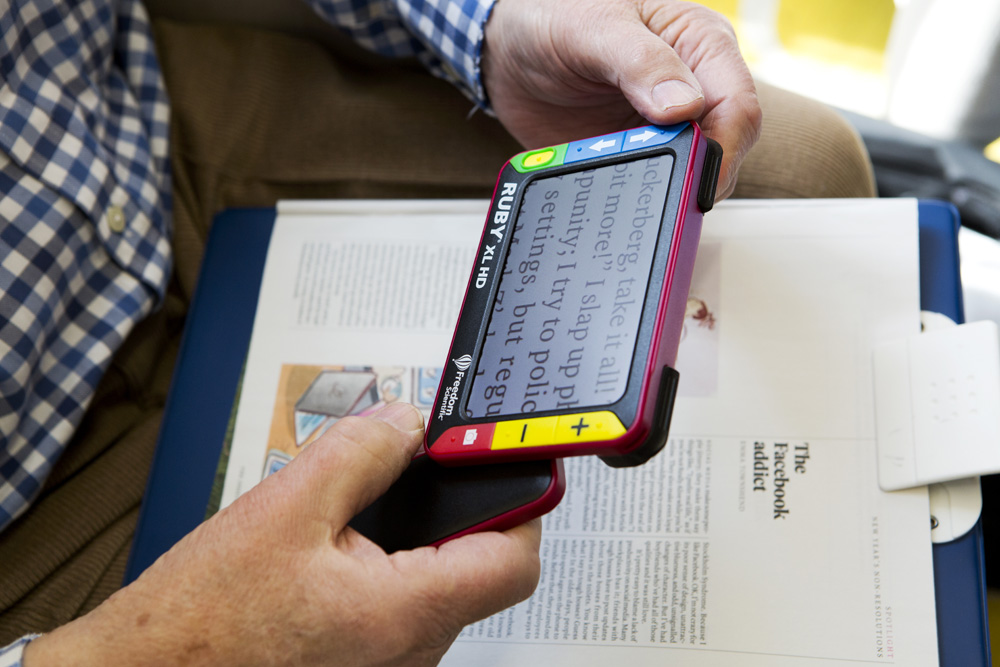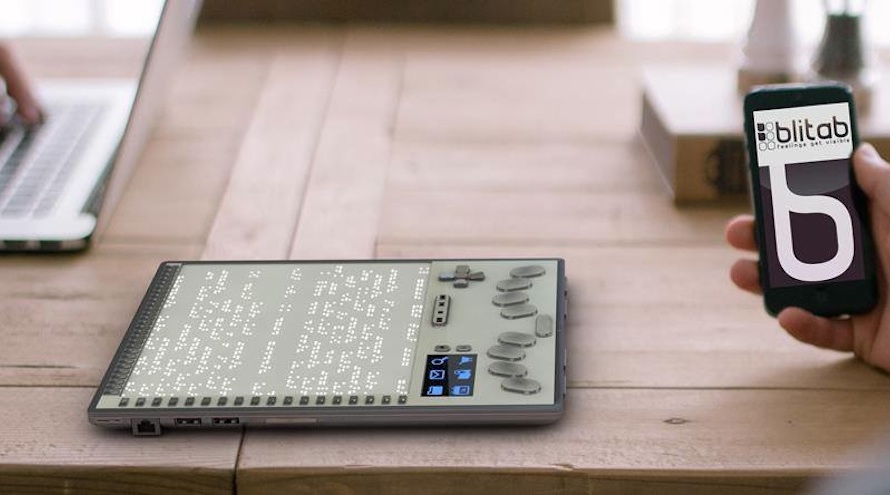Mobility Aids for Visually Impaired Users: Improving Independence
Mobility Aids for Visually Impaired Users: Improving Independence
Blog Article
Discover Innovative Devices Developed for the Visually Impaired
The growth of cutting-edge devices for the aesthetically impaired stands for a considerable innovation in ease of access and freedom. Technologies such as wise glasses with AI abilities and mobile applications developed to offer auditory descriptions are reshaping daily experiences for customers. Additionally, wearable devices that employ haptic comments boost environmental understanding, while modern Braille advancements supply new methods to involve with message. As these tools remain to develop, their influence on the lives of those with aesthetic disabilities increases crucial inquiries about the future of inclusivity and freedom in various aspects of life. What lies ahead in this technological landscape?
Smart Glasses for Navigation

Smart glasses made for navigating are reinventing the way aesthetically impaired people communicate with their environment. These advanced devices use a combination of camera modern technology, fabricated intelligence, and auditory responses to provide real-time details about environments. By employing obstacle detection systems, smart glasses can signal individuals to possible dangers, making it possible for much safer mobility in both strange and familiar settings.
The combination of GPS innovation further improves navigation capacities, allowing customers to receive acoustic instructions as they move. This hands-free approach not only promotes freedom yet additionally empowers visually damaged individuals to navigate metropolitan landscapes with enhanced self-confidence. Furthermore, several wise glasses are furnished with functions that determine spots and road signs, providing contextual information that improves the user experience.
Moreover, the development of these tools is consistently advancing, with business working to enhance the accuracy of things recognition and increase the series of navigational features. As smart glasses become much more accessible and economical, they hold the prospective to substantially change day-to-day life for visually impaired users. Inevitably, these ingenious tools stand for a crucial step toward inclusivity, offering enhanced movement and a greater sense of autonomy for people navigating the world around them.

Mobile Application for Daily Living
Exactly how can mobile applications improve the every day lives of aesthetically damaged people? Mobile apps are reinventing the way visually damaged individuals navigate their settings, manage day-to-day tasks, and accessibility information. These applications supply important support with various capabilities, cultivating freedom and improving top quality of life.
Several ingenious mobile applications are created particularly for day-to-day living. For example, applications like Be My Eyes connect visually impaired individuals with sighted volunteers using video telephone calls, enabling them to get real-time aid with tasks such as reading labels or navigating unknown areas. Seeing AI, developed by Microsoft, utilizes artificial intelligence to explain environments, reviewed message, and recognize items, effectively transforming a mobile phone right into an effective device for daily aid.
Furthermore, navigating apps customized for the aesthetically impaired, such as Aira and BlindSquare, supply audio-based directions and environmental info, making it possible for individuals to traverse their environments securely and confidently. Past navigation and prompt help, mobile apps additionally support company and task monitoring, with attributes that aid customers set tips, create order of business, and track consultations. In recap, mobile applications act as vital sources, encouraging visually impaired people to lead more independent and meeting lives.
Wearable Technologies for Help
Empowerment via modern technology is significantly evident in the realm of wearable devices created to assist visually impaired people. These cutting-edge tools incorporate effortlessly into life, enhancing navigating and providing important responses to customers. For example, smart glasses furnished with video cameras can recognize faces and review message aloud, enabling users to connect more with confidence in social and specialist setups.
An additional notable advancement is using haptic responses systems in wearable devices. These systems use vibrations or other tactile signals to share Learn More details regarding the individual's atmosphere, such as barriers or modifications in surface, enhancing movement and safety and security. Wearable modern technologies also consist of wristbands that connect to smart devices, alerting individuals to notifications via refined resonances, hence boosting connection without reliance on visual cues.
As these technologies remain to advance, they are not only improving freedom for visually damaged people yet likewise cultivating a greater feeling of incorporation in culture. By bridging the space in between challenges dealt with in everyday living and the potential for freedom, wearable technologies work as essential tools in the quest for equality and empowerment for those with aesthetic problems.
Sound Summary Tools
Sound summary devices play an essential function in improving access for aesthetically impaired people, offering them with the capability to engage with aesthetic media. Smart glasses for the visually impaired. These tools supply narrated summaries of vital visual elements in films, television programs, and live efficiencies, guaranteeing that customers can totally comprehend the context and emotions communicated through visuals
Sound summary can be integrated right into various systems, including streaming services, cinema screenings, and live cinema. Numerous popular streaming services currently include audio description as an ease of access function, enabling customers to choose it quickly. Home Page In addition to conventional media, specialized apps likewise exist, giving audio summaries for art exhibits, museums, and other social occasions.
The efficiency of audio description rests on the ability of the narrators, that must communicate visual information succinctly without taking away from the original sound. Developments in this field are likewise paving the way for even more individualized experiences, where customers can adjust the degree of detail and pacing according to their choices.
Braille Innovations and Tools
Braille learn this here now technologies and gadgets have dramatically transformed the way aesthetically damaged individuals engage with text and details. Modern innovations have actually led to the growth of functional devices that enhance literacy and self-reliance among individuals. Especially, Braille present innovations have actually advanced, permitting dynamic analysis experiences. These tools transform digital text right into Braille, allowing users to access a huge range of details on computers, mobile phones, and tablet computers.
Moreover, mobile Braille notetakers incorporate standard Braille input with contemporary performances, facilitating note-taking, scheduling, and document editing on the go. Mobility aids for visually impaired users. These small gadgets often include text-to-speech capabilities, bridging the gap in between Braille and acoustic information
On top of that, cutting-edge Braille printers have actually arised, enabling individuals to generate Braille labels, records, and instructional materials efficiently. This ease of access promotes better involvement in professional and instructional atmospheres, eventually promoting inclusivity.
Moreover, study right into clever Braille technologies continues to increase. Devices that incorporate expert system are being discovered to give real-time navigating support and contextual info, improving the individual experience in diverse settings. In general, these innovations mirror a commitment to equipping aesthetically damaged people with innovation, ensuring they can conveniently gain access to and involve with the globe around them.

Conclusion
The improvement of ingenious tools for the aesthetically damaged significantly boosts self-reliance and high quality of life. These innovations not only foster greater inclusion but likewise advertise freedom in everyday tasks, ultimately adding to a much more easily accessible and equitable culture for visually impaired individuals.
As clever glasses come to be extra available and budget-friendly, they hold the potential to significantly change day-to-day life for aesthetically damaged individuals. Mobile applications are transforming the means aesthetically impaired users navigate their settings, take care of everyday jobs, and accessibility details. Apps like Be My Eyes connect visually impaired users with sighted volunteers using video clip phone calls, allowing them to receive real-time help with tasks such as reading tags or navigating unfamiliar areas.Furthermore, navigation apps customized for the aesthetically impaired, such as Aira and BlindSquare, offer audio-based directions and environmental information, allowing individuals to traverse their surroundings securely and with confidence.The advancement of innovative tools for the aesthetically impaired substantially enhances self-reliance and top quality of life.
Report this page